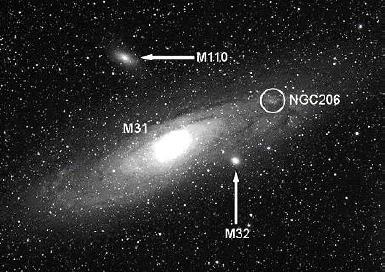LCAS Observer Challenge - November
Dave Wagner

Photo M31 Andromeda Galaxy - Courtesy Steve Ruppa
In the Nov/Dec Challenge block, we'll be spending a majority of our time in the constellation of Andromeda. Objects M31, M32, M110, NGC206, NGC891, NGC7662 and the ternary star Almach, all reside in that constellation. The first four of these objects reside within about a degree of each other as shown in the photo above. M31, aka the Andromeda Galaxy is the nearest major galaxy to our own Milky Way galaxy. Readily visible with the naked eye, well defined in dark skies with binoculars, it is over 2 million light years distant from us. Over 65,000 light years across and four times as massive as our own Milky Way galaxy, it spans the equivalent of more than 4 full moons in terms of field of view. Along with M31, our Milky Way galaxy, M32 and M110 are the key components of our galactic neighborhood, called the Local Group.
While these first three objects tend to be binocular and telescope friendly, the last one, NGC206 is definitely more of a challenge. NGC206 is the largest known starforming region in our Local Group of galaxies. This star cloud with young blue stars is located along one of the arms of the Andromeda galaxy, a challenge to discern from the foggy starlight of M31.
My favorite rating in this block of many favorites goes to Gamma Andromedae, or "Almach". The color simply surprised me! A ternary star of 2.3, 5.5 and 6.5 magnitudes, with orange, emerald and blue colors respectively, resolved out only as a double at my last viewing, as a rich yellow and GREEN star pair! I had to double check to make sure I didn't have a filter on my eyepiece, and then looked again... still green! I'm really looking forward now to 95 Herculis in the May/Jun block, described by some as 'red and green apples'. With all the shades of gray in the telescope, a little color sure can put a smile on your face on a cold observing night!
The Challenge list for November/December includes the following, which includes some new non-Messier objects:
| Object | Description | Const. |
|---|---|---|
| NGC 7662 | (Blue Snowball) Planetary nebula | And |
| NGC 7510 | Open cluster | Cep |
| M110 | Galaxy | And |
| NGC 206 | Star Cluster (Star Cloud in M31) | And |
| M32 | Galaxy | And |
| M31 | (Andromeda Galaxy) Galaxy | And |
| Eta Cassiopeiae | Double Star | Cas |
| NGC 869 | (part of Double Cluster) Open cluster | Per |
| NGC 884 | (part of Double Cluster) Open cluster | Per |
| Almach | Star (Multiple) | And |
| NGC 891 | Galaxy | And |
| NGC 1502 | Open cluster (on Kemble's cascade) | Cam |
| M45 | (Pleiades, Seven Sisters) Open cluster | Tau |
| NGC 246 | Planetary nebula | Cet |
| M77 | Galaxy | Cet |
| M38 | Open cluster | Aur |
| M35 | Open cluster | Gem |
| NGC 2169 | Open cluster | Ori |
The complete Challenge list is on the LCAS member Yahoo! Web site.
A Note on Star Color
Dave's observation of Almach noted one component of this system as being green in color. That is a common perception. In his Celestial Handbook, Robert Burnham identifies one of the stellar members as appearing greenish-blue. Gamma Delphini is another star that looks green in color. But stars simply don't radiate in this "impossible" green color. It's generally conceded that the perception of green is purely in the eye of the beholder, caused by a comparison with nearby stars of contrasting color. In fact, cameras have even recorded the green color. There's been some argument about the real color, but most experts seem to agree that this is a case where the imaging medium (film or CCD) is responding very much like the human eye, because after all, their purpose is to record what we see. So take a look at Almach and see how it appears to you. It'll be interesting to compare a number of observations among ourselves.
Jack Kramer
Published in the November 2004 issue of the NightTimes




